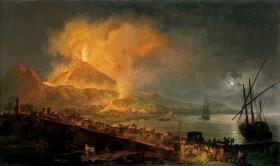
. . . This amazing mountain continues to exhibit such various scenes of sublimity and beauty at exactly the distance one would choose to observe it from—a distance which almost admits examination and certainly excludes immediate fear. When in the silent night, however, one listens to its groaning, while hollow sighs, as of gigantic sorrow, are often heard distinctly in my apartment, nothing can surpass one’s sensation of amazement . . .
This description of Mt. Vesuvius was written in 1786 by Hester Thrale, one of many travelers who made Naples a destination on their Grand Tour of Europe. The Grand Tour, popular among wealthy Englishmen during the eighteenth century, was an extended sojourn through Europe to admire Classical ruins, picturesque landscapes, and artistic masterpieces, in order to complete a gentleman’s education. Pompeo Batoni, Canaletto, and the French Chevalier Volaire made careers in Italy executing souvenir pictures for English travelers. Volaire painted more than thirty scenes of Mt. Vesuvius, among the principal natural attractions of the continent because it erupted periodically throughout the century. Volaire contrasts the moods of nature; the cool, calm water reflecting moonlight and fire is juxtaposed to the violent explosion and fiery terror. Along the bridge he includes references to St. Januarius, protector of Naples from volcanic destruction: from left to right are a statue of the saint, a fleeing townsman holding an image of the saint toward the mountain, and people praying before a drawing of the holy figure posted to a stone pier.

